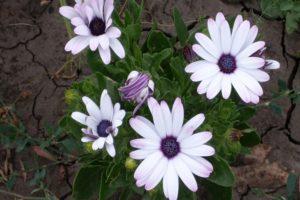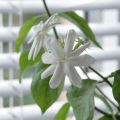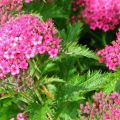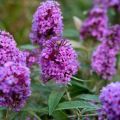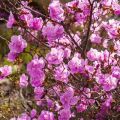Planting and caring for jasmine, propagation of shrubs, pruning and transplanting
Modern flower growers grow jasmine not only on the windowsill, but also in the open field. Ornamental shrub, planting and care, the reproduction of which is in many ways similar to the mock-orange, serves as an excellent decoration for the garden and fills it with a fabulous scent during the flowering period. The plant has some features of agricultural technology and care, which you need to familiarize yourself with before planting it on your site.
Features and uniqueness of garden jasmine
Jasmine is native to the Mediterranean, where it is used as a medicinal plant. In our country, the shrub is most often grown for the purpose of decorating a certain territory. A beautiful and lush crown, decorated with large white inflorescences, instantly attracts the eye. And the alluring sweet aroma does not leave indifferent even the most demanding gardener. Jasmine quickly adapts to weather conditions, which is another of its benefits.
The uniqueness of the plant lies in the fact that the flowers during their blooming contain a huge amount of essential oils that have a beneficial effect on the human body. The bush buds are used both for medicinal purposes and as an additive to black and green tea to increase immunity, cleanse from toxins. Due to its healing properties, jasmine is not only an excellent decoration for the site, but also helps to improve health.
What varieties are recommended for planting in the garden
At the dacha, three main varieties of jasmine are grown, which became the basis for breeding many varieties:
- small-leaved;
- coronal ordinary;
- fluffy.

It is best to use jasmine varieties to decorate your own site:
- Moonlight;
- Dwarf;
- Charm;
- White bouquet;
- Ermine mantle;
- Arctic;
- Pompon;
- Salute;
- Obelisk;
- Charm;
- Kazbek.
Separately, it is worth highlighting the Ermine mantle, in which the flowering period lasts up to 2 months, and the inflorescences are located along the entire length of the branches, which gives jasmine a special decorative effect.

What to consider when growing
Jasmine is not a capricious shrub, but it has certain growing characteristics that must be taken into account when planting a plant.
Required soil composition
Almost any soil that has a sufficient supply of nutrients is suitable for planting jasmine. The root system of the shrub does not tolerate waterlogging, therefore the groundwater level should not come too close to the surface. If there is not enough nutrition in the soil, this will affect the beauty of flowering.
The optimal composition of nutrient soil for ornamental shrubs is a mixture of humus and river sand (1 part of each), as well as turf soil (2 parts).
Requirements for lighting the place
If you have to choose where to plant jasmine on the site, then preference should be given to a well-lit place. The shrub also feels good in partial shade, but in such conditions it is impossible to achieve lush flowering.
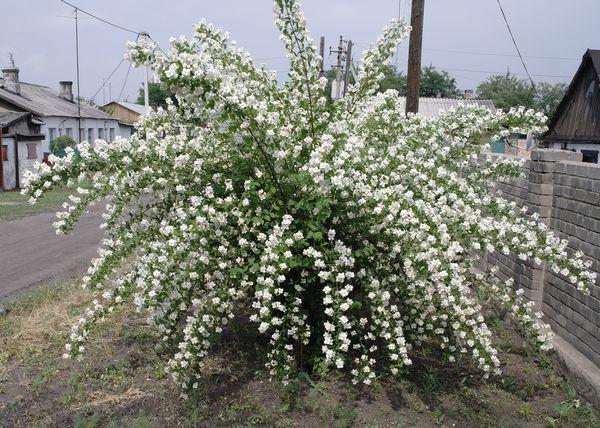
Suitable and unsuitable neighbors
Jasmine is best planted next to dark blue or purple flowers. Good neighbors for the bush will be:
- delphinium;
- lavender;
- hydrangea;
- spirea.
You can not plant jasmine near apple and pear trees, since these fruit trees suffer greatly from such a neighborhood.
Planting technology
The health and further development of the shrub depends on the correctness of the planting work. Jasmine will delight you with exuberant flowering only if agricultural technology and all the rules for planting on the site have been followed.
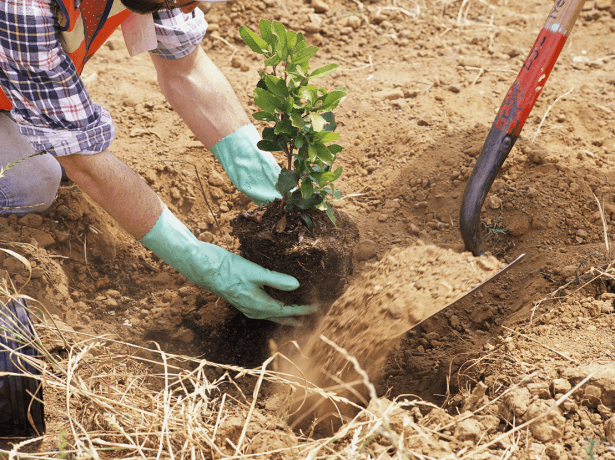
Selection and preparation of a seedling
Shrub planting material should be purchased only in the spring at reputable retail outlets or taken from friends who you can trust and not doubt the quality and varietal affiliation of the seedling. For planting, it is preferable to take jasmine with open roots and unblown buds. If leaves have already begun to appear on it, then the chances of settling down are reduced to almost zero.
For planting, it is better to give preference to a shrub 1-2 years old. In this case, its root system is already sufficiently developed, but it is less likely to be damaged when excavated.
Jasmine should not show signs of disease, pest infestation or mechanical damage. At the point of sale, the root system of the plants should be dug in or covered to prevent drying out.
The timing and technology of planting
It is recommended to plant jasmine exclusively in spring. The planting hole is dug 0.5 m deep. Its width is about the same, but the exact size depends on the dimensions of the root system of the shrub. A distance of about 10 cm is left from the edges of the pit to the root, and the root collar does not deepen by more than 3 cm.
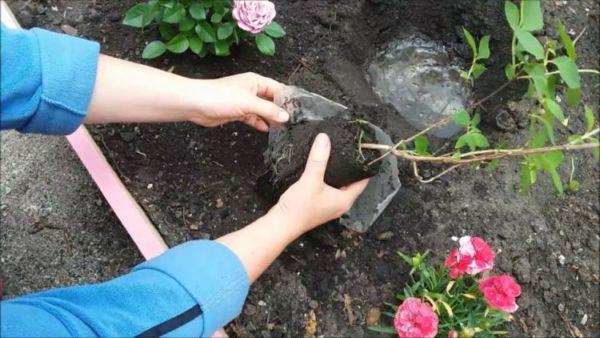
A drainage layer of sand, expanded clay and small stones is poured at the bottom of the prepared hole for planting jasmine to prevent stagnation of water. It is advisable to add a small amount of nitrophosphate to the soil mixture so that the seedling gains strength faster. Part of this mixture is poured over the drainage in a mound, then the jasmine is installed and the roots are carefully straightened. The hole is covered with the remaining nutritious soil, tamped and watered abundantly. After that, mulching of the periosteal circle is carried out.
If several jasmine bushes are planted in the open field, then a distance of at least 1 meter is left between them. The exception is dwarf varieties, which are allowed to be planted at a distance of 0.6-0.8 m from each other.
How to care for your culture
It is important not only to plant jasmine on the site, but also to provide it with proper care so that the shrub will please with abundant flowering.
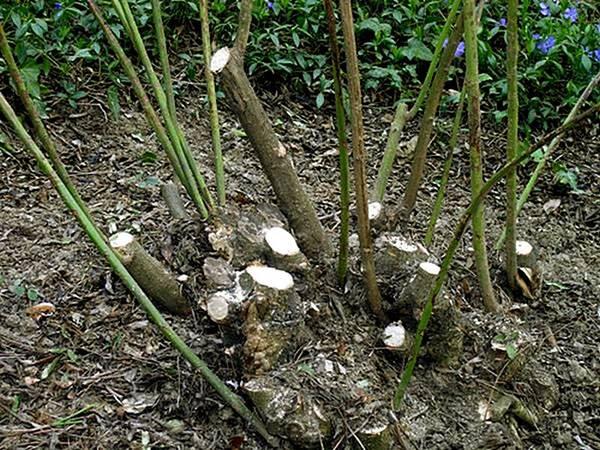
Watering frequency
Jasmine does not require frequent watering, provided it is grown in the middle lane. The shrub is irrigated only in case of prolonged drought and hot weather.The need for moisture is determined by the state of the top layer of the soil and the jasmine itself, the leaves of which lose their elasticity. Up to 30 liters of warm water is added under each plant. In the autumn, before the onset of cold weather, moisture-charging watering is done so that the shrub can easily endure the winter and not freeze.
Top dressing
Top dressing is required for jasmine from the second year of life. Fertilizers are applied throughout the growing season, using both organic matter and mineral mixtures. In summer, shrubs need more nitrogen, so it is recommended to add urea, superphosphate, and potassium sulfide. From organic matter, manure and humus are used. The recommended dosages should be strictly observed. Otherwise, the shrub will suffer from excess nutrition, will increase its green mass and will not show violent flowering.

Loosening and care of the trunk circle
Loosening of the soil in the near-trunk circle of the bush is carried out after each heavy rainfall or watering. Do this carefully and not too deeply so as not to damage the jasmine root system. All weeds are removed at the same time.
Pruning
Pruning is an important part of jasmine bush maintenance. If done correctly, the plant will look aesthetically pleasing, develop properly and bloom violently.
Formative
Jasmine shaping pruning is more commonly done in early spring. In the fall, it does not make much sense, since during the winter some of the shoots may break, freeze or simply die off. To form a beautiful bush, you need to cut off too long branches, and remove diseased or dried ones altogether. Poorly developed processes are shortened in half to provoke the growth of young branches. This scheme allows you to make the jasmine bush lush, thick and beautiful.
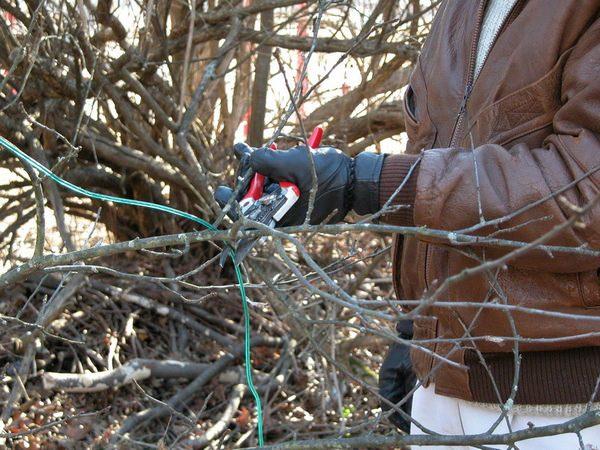
Sanitary
Typically, sanitary pruning is done in the spring. All broken or frozen branches are removed before bud break. Shoots with signs of the disease are subject to immediate removal. If the autumn sanitary pruning of jasmine is carried out, then the plant is carefully examined for mechanical damage, the presence of dry shoots or too old shoots, which are best removed immediately.
Pruning jasmine after flowering
Immediately after the end of the flowering of the jasmine bush, it is examined and, if necessary, pruned. Dead inflorescences, weak and diseased branches are removed.
Anti-aging
Over time, the jasmine bush grows old and loses its attractiveness. Bare shoots not only spoil the view, but also impede the growth of young twigs. As a result, flowering is not so exuberant. In this regard, the plant needs rejuvenating pruning once every few years. Work is carried out in the spring, before bud break. Choose 4 or 5 attractive stems and shorten them by 50% of the length, the rest are simply cut at the root.
Cutting places are treated with garden pitch. With the beginning of sap flow on the stumps, buds will wake up and give new shoots, from which several of the strongest are chosen. It is they who will form the crown of the renewed jasmine.

When to transplant to a new location
Transplanting a jasmine bush to another place is rarely done, in case of emergency. The reasons for this may be various, for example, closely growing trees began to block the access of light to the shrub. There is a debate among gardeners about when to replant the plant so that the stress does not turn out to be too strong for it. Most agree that work should be planned for the spring. The procedure itself is not much different from the usual jasmine planting on the site.
To transplant it to a new place, it is necessary to dig a planting hole, which will correspond in volume to the root system.
It is preferable to dig out the bush together with a lump of earth and not shake it off when transplanting.
Treatment and treatment of diseases and pests
The jasmine bush is most often affected by pests such as:
- weevil;
- spider mite;
- aphid.
As a result of their impact, the shrub loses its decorative properties, ceases to develop normally, its foliage curls up into a tube. At the initial degree of damage, the leaves of the plant are removed along with the pests and burned, and the jasmine is treated with a solution of laundry soap. In case of severe damage, insecticides are used.
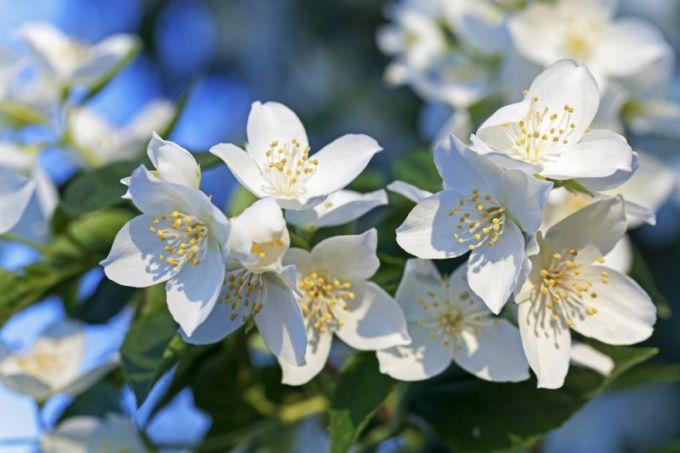
Jasmine is highly resistant to diseases, which are most often caused by lack of nutrients. For prevention purposes, it is recommended to apply complex mineral fertilizers.
Preparing a shrub for winter
For garden jasmine to easily endure the winter outdoors, it will need proper and good preparation. An adult shrub tolerates the cold season better than a young one, therefore it does not need special preparation and insulation. Young specimens, immediately after the end of the flowering period, are covered with a specially designed material for this, or ordinary straw is used. The soil in the near-trunk circle of the bush is dug up and compost is introduced into it.
Reproduction methods
If desired, garden jasmine can be easily propagated by yourself. There are several proven techniques with good results.

Division of the root system
To quickly get a blooming jasmine bush, you can propagate it by dividing the root. However, this technique is only suitable for low-growing varieties, but plants up to 4 meters high in this way are problematic to propagate. Jasmine is dug out of the ground and divided into several parts so that young growth remains on each of them. The work is carried out using a garden pruner. The resulting shrubs are planted in prepared holes.
Propagate by layering
This technique allows you to propagate any type of jasmine and at the same time guarantees an excellent result. Works are carried out in the summer. Young shoots growing around an adult mother bush are selected and pulled with a wire below their own lower bud. This will stimulate root formation.
A twig of a bush is bent to the ground and placed in a prepared shallow groove, fixing it with wire and sprinkling it with earth.
In the place of contact with the ground, roots form within a month. After some time, young shoots are formed from the rooted jasmine cuttings. The following spring, the mature bush is cut off from the mother plant and transplanted to a permanent place of growth.
Using cuttings
Jasmine propagation by cuttings is the simplest, most reliable and common way. It is preferable to harvest young shoots in the summer, but you can cut them off in the fall. They must be flexible and not break. Cutting is done in the morning so that there is enough moisture in the processes. The lower leaves are immediately removed, and the upper ones are shortened by 2 times.
For a day, the petioles are left in a solution of a root formation stimulator, after which they are planted in a greenhouse or a small greenhouse, deepening a few centimeters. As a last resort, planting shrubs is covered with scraps of plastic bottles. At first, the shelter cannot be raised, but after three days you will need to do daily airing.
Jasmine needs to maintain constant humidity, but not allow the soil to turn into a swamp. The petioles should receive enough light, but direct sunlight should not be allowed. After 2 weeks, the jasmine forms a root system and begins to develop.

